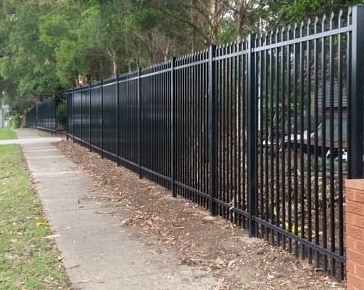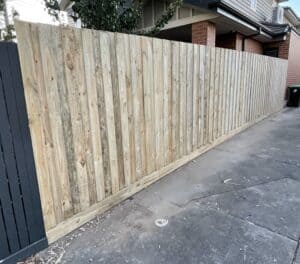Introduction
When it comes to fencing, wood holds a timeless appeal that frequently stands the test of time. However have you ever stopped to consider how the type of wood grain can play an essential function in your option of wood fence product? Whether you're searching for aesthetic appeal or tough performance, comprehending wood grain is key. Not just does it impact the total appearance of your fence, but it also affects its resilience and upkeep needs.

In this extensive guide, we will delve into The Role of Wood Grain in Selecting the Perfect Wooden Fence Material From different kinds of wood grain to their useful ramifications, we'll explore different factors you need to think about when selecting your ideal wooden fence. So get a cup of coffee and let's get started!
The Function of Wood Grain in Choosing the Perfect Wooden Fence Material
Understanding Wood Grain
Wood grain refers to the pattern and texture found on the surface area of wood. It is specified by the growth rings formed as a tree matures. The arrangement and appearance of these grains differ significantly between various species, which affects both aesthetics and performance.
Types of Wood Grain Patterns
Straight Grain: Consistently parallel lines that develop a clean look. Wavy Grain: Curved patterns that add unique visual interest. Interlocked Grain: Grains that twist around each other; known for strength. Spiral Grain: Twists around the trunk, using distinct patterns.Each type has its own characteristics that add to both beauty and functionality.
Why Wood Grain Matters
So why should you appreciate wood grain? The answer lies in several factors:
- Aesthetics: A visually appealing fence can enhance your residential or commercial property's total curb appeal. Durability: Different grains might use differing levels of resistance against environmental stressors. Maintenance: Some wood grains require more maintenance than others, impacting long-lasting costs.
Choosing Your Wooden Fence Material
1. Assessing Your Needs
Before diving into specific materials, it's essential to identify what you're searching for in a wood fence:
- Are you focusing on visual appeals or durability? What climate conditions will it be exposed to? Do you have specific design preferences?
These questions will assist your decision-making process.
2. Common Types of Wood Utilized for Fencing
With many choices on the market, here are some popular options among wood fence business:
- Cedar Natural resistance to decay Distinctive grain patterns Pine Cost-effective option Requires treatment for longevity Redwood Known for abundant color and resistance to warping Unique grain patterns boost beauty Teak Extremely resilient with tight grains Often more costly but worth considering for luxury properties
Comparison Table: Typical Types of Wood Fencing
|Type|Toughness|Aesthetic Appeal|Maintenance Requirements|| ----------|------------|-------------------|--------------------------|| Cedar|Moderate|High|Low|| Pine|Low|Moderate|High|| Redwood|High|Really High|Moderate|| Teak|Very High|Luxurious|Low|
Factors Influencing Your Choice
Environmental Considerations
The local climate plays a significant function in determining which type of wood appropriates for your fencing task:

- In damp climates, choose woods with natural decay resistance like cedar or redwood. In dry locations, ensure your selected wood can hold up against extreme heat without warping.
Budget Constraints
When picking wood fencing materials, budget considerations are essential:
Material Costs: Various types come at differing prices. Installation Costs: Employing professional fence builders may add up. Maintenance Costs: Think long-term! Some woods require more maintenance than others.How Wood Grain Influences Durability
Density and Strength
The density of the wood typically associates with its strength and sturdiness:
- Denser woods tend to be more resistant to wear and tear.
For example:
- Teak has a high density, making it among the strongest options available. Pine is less thick however can still perform well if treated properly.
Resistance to Elements
Different kinds of wood grains have various levels of natural resistance versus elements such as wetness and insects:
Cedar has natural oils that push back insects and resist rot. Redwood includes tannins that likewise use comparable protective qualities.
Visual Appeal-- The Visual Value
Color Variations Among Various Woods
Each type has its own intrinsic colors that add to its visual appeal:
- Cedar normally showcases warm tones ranging from reddish-brown to pale yellow. Redwood presents crimsons with appealing color variations depending upon light exposure.
Sample Color Chart for Typical Woods Utilized in Fencing
|Type|Color Range|| ----------|-----------------------------------|| Cedar|Reddish-brown, Yellow|| Pine|Light Yellow|| Redwood|Deep Red|| Teak|Golden Brown|
How Wood Grain Impacts Visual Texture
The texture created by various wood grains contributes considerably to how a wooden fence matches your home or landscape style:
Straight-grained woods supply an organized appearance perfect for contemporary homes. Wavy or interlocked grains add character and originality appealing for rustic designs.Practical Applications in Fencing
Timber Paling Fences vs Picket Fences
Timber paling fences are fantastic for personal privacy while picket fences provide themselves well to charm and curb appeal:
Timber Paling: Offers strong panels with increased height; excellent for security fences. Picket: Normally lower; perfect around gardens or front lawns where visibility is desired.Pros & & Cons Table: Lumber Paling vs Picket Fences
|Type|Pros|Cons|| ------------------|---------------------------------------------|------------------------------|| Timber Paling|Excellent privacy/security; strong|Can be more pricey|| Picket|Charming aesthetic; lower cost|Less privacy/security|
Maintenance Considerations
Cleaning Your Wooden Fence
Regular cleansing assists maintain aesthetics and longevity:

Treatment Alternatives For Longevity
To boost durability versus weathering:
Stain every couple of years assists safeguard against UV rays. Sealant application prevents moisture penetration while preserving color.FAQs About Choosing Wood Fences
Q1: What is the very best wood type for fences?
A1: Cedar is typically suggested due to its natural decay resistance combined with stunning grain patterns.
Q2: How do I maintain my wood fence?
A2: Regular cleaning followed by staining and sealing every few years will keep it looking great as new!
Q3: Can I install my own wooden fence?
A3: While do it yourself setup is possible, employing professional fence installers Melbourne makes sure correct setup which can conserve costs in repairs down the line.
Q4: How do I select in between timber paling fences or Colorbond fences?
A4: If personal privacy is crucial, lumber paling may be much better; nevertheless, Colorbond offers modern-day visual appeals with low maintenance requirements.
Q5: Do I need licenses before installing a wood fence?
A5: Regional policies differ-- talk to local authorities or seek advice from fencing contractors Melbourne beforehand!
Q6: Exist eco-friendly options available?
A6: Yes! Search for sustainably sourced timber alternatives from credible providers promoting responsible forestry practices.
Conclusion
Understanding The Role of Wood Grain in Picking the Perfect Wooden Fence Material is essential when making choices about fencing solutions tailored specifically for your needs-- both practical and visual! Armed with understanding about different types available along with their benefits & & downsides relating to upkeep expenses versus preliminary investment quantities will empower you while dealing with any https://onthefencing.com.au/ timber fence company or fencing contractors Melbourne out there!
Remember-- your option not just specifies boundaries however shows personal style too! So take your time exploring all possibilities before settling down on what suits YOU finest! Delighted fencing!